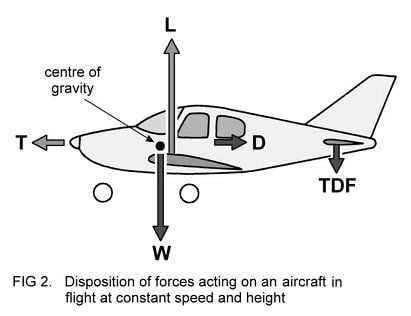From 'Handling Light Aircraft' by Julien Evans:
 3.8.1 Longitudinal stability
3.8.1 Longitudinal stability
Remember that the tailplane generates the tail down-force, and that this force, because of the manner in which it is generated, responds to the same factors which affect the lift force generated by the wings.
Suppose that while an aircraft is in level flight, a gust of air disturbs it, causing the nose to pitch upwards. The aircraft will now start to climb, decelerating as it does so (in the same manner as a car tends to slow down as it runs up a hill).
The reduced speed will decrease the tail down-force. From consultation of Figure 2, we can see that in this situation the lift force, acting behind the CG as it does, will now raise the tail, so restoring the aircraft to level flight. Thus although the gust upsets the aircraft, the stability conferred by the tailplane will soon restore it to its original flight path.
If a gust pitches the nose downwards, the aircraft will start to descend, accelerating as it does so. The faster speed will increase the tail down-force and the tailplane will be pulled down, again bringing the aircraft back to level flight.
3.8.5.1 Effect of position of centre of gravity on longitudinal stability
The tail down-force has the stabilising effect of bringing the nose of the aircraft back to its original position after disturbance. Refer back to Figure 2, which showed the usual disposition of the weight force, the lift force and the tail down-force during flight. It is possible for the pilot to vary the magnitude of the tail down-force, using the aircraft's controls.
Now, suppose that the aircraft is loaded so that its CG is further rearward, coinciding with the point from which the lift force acts, as in Figure 121. In this case, the original tail down-force would now pull the tail down, thus pitching the nose up.
To prevent this, the pilot would have to use his controls to reduce the tail down-force to zero, thus restoring the equilibrium. But now, if a gust upsets the aircraft, the tailplane will have no stabilising effect, because, regardless of the aircraft's speed, the tail down-force would remain zero.
Taking the argument a stage further, suppose now that the CG was so far to the rear that it was behind the point from which the lift force acts, as in the top image in Figure 122.
It can be seen that the lift force, because it is now acting ahead of the CG, will have the effect of pitching the nose up, and to prevent this from happening, the pilot would have to adjust his controls so that the tail force acted upwards, as in the lower image in Figure 122.
Well, the equilibrium has been restored again, but imagine that a gust now pitches the nose down. The aircraft will, of course, start to accelerate––the tail force will increase, pulling the tail further up, and the situation would quickly develop into a steep dive. In other words, the aircraft is longitudinally unstable. (The reader is left to prove that this instability would aggravate any pitch up of the nose caused by a gust.)
The conclusion can be drawn that, as the CG of an aircraft is positioned further rearwards, so its longitudinal stability decreases, and, at extreme rear CG positions, the aircraft may become longitudinally unstable. Conversely, forward CG positions enhance longitudinal stability. (However, extreme forward positions of CG have a detrimental effect on aircraft controllability, for reasons which will be explained later.)
Now it can be understood why the manufacturer specifies limits for the CG positions in his aircraft. A CG position outside these limits renders the machine unsafe for flight. The importance of correct loading can be appreciated, and one of the pilot's responsibilities is to ensure that this requirement is complied with.